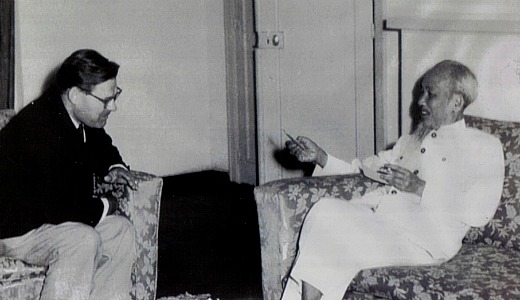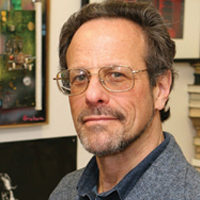
Author Phillip Bonosky, a member of the Communist Party since 1938, died Saturday, March 2, in Brooklyn, N.Y. He was 96. Known for his labor novels “Burning Valley” and “The Magic Fern,” Bonosky distinguished himself as one of the first U.S. journalists to visit socialist China and one of the few to interview Vietnamese revolutionary leader Ho Chi Minh. He also was one of a handful to witness the removal of the notorious Khmer Rouge in Cambodia and the destabilization of Afghanistan prior to the rise of the Taliban. (Article continues after slideshow.)
Bonosky epitomized the labor and Communist activists from the 1930s. He also exemplified a certain type of writer of that period, one with roots in labor and union struggles. In his writing style, Bonosky assimilated several dimensions. Raised in the Catholic Church in Western Pennsylvania as the son of devout immigrants, he grasped the religious traditions helping to influence and shape the contours of labor movements. He honestly portrayed negative and positive influences therein. Knowledge of corporate domination of peoples’ lives in small industrial towns, and familiarity with how workers actually produced, energized his insights in print.
Bonosky came from the steel-producing town of Duquesne, Pa. An altar boy, he grew up hearing stories from the survivors of the famous 1892 strike in nearby Homestead, where his family attended church, and the labor walkout of 1919, a valiant attempt to organize steelworkers industry-wide, which was headed by future Communist Party Chairman William Z. Foster, to whom Bonosky would draw close. Like his father and brothers, Bonosky worked in Duquesne and Pittsburgh mills. Before being blacklisted from employment due to his Communist Party affiliation, he belonged to Local 1256 of the United Steelworkers.
At his best in fiction writing, his work covered the social and class ramifications of family life, high school basketball, homelessness, chronic illness, and communities. He could write with grace, but took all his subject matter personally. He wrote to enlighten, provoke, and inflame. In fiction and non-fiction, there was no secret as to where he stood. He counseled new and young writers to directly confront the challenges of writing: to work hard at it; to write regularly, if not daily; to get to the point; to avoid jargon; to acknowledge the pitfalls of “writer’s block,” but at least to get out a paragraph before surrendering to it.
He developed a love for writing at an early age. He was among the most frequent visitors to the Duquesne Public Library as a teenager. He was likely one of the most disciplined and prolific diarists who ever lived; he documented his life nearly everyday for 75 years, a legacy that fills two large file cabinets in his daughter’s attic.
Bonosky came to New York in the late 40s, convinced that he could make his most important contributions to the causes he espoused through writing. His first short stories appeared in noted magazines of the 1940s, such as Collier’s and Story Magazine. He produced his first books in 1953: the steel town novel “Burning Valley” (reissued by University of Illinois in 1997) and “Brother Bill McKie,” a United Auto Workers leader.
He held writing workshops at the Communist Party’s Jefferson School and a Harlem workshop. In the 1950s, he contributed to the literary journal Masses & Mainstream, along with screenwriter John Howard Lawson, novelist Meridel LeSueur, singer-activist Paul Robeson, and historian Herbert Aptheker. His long friendship with left-wing painter Alice Neel is detailed in Phoebe Hoban’s “Alice Neel: The Art of Not Sitting Pretty” and in Andrew Neel’s acclaimed documentary of the artist.
His second novel, “The Magic Fern,” appeared in 1960, followed by “Dragon Pink on Old White,” about Chinese culture. “The Magic Fern” provided readers with a close-up portrait of Communists in the labor movement at the end of the Cold War. The blacklisted Bonosky was well familiar with anti-Communism as a labor organizer and FBI target (demonstrated in a host of newly released documents), and as the brother of Toni Nuss, stigmatized in the sensationalist press as the “Red Queen of Pittsburgh.”
In the Great Depression, Bonosky “rode the rails” looking for work and eventually landed in Washington, D.C., living in a warehouse for the homeless under the auspices of the Transient Bureau, where his social worker was Ann Terry White. White’s husband was Treasury Department official Harry Dexter White, later hounded to death by anti-Communists during the Cold War. Through assistance from the Whites, odd jobs, and a monthly payment of $20 from the National Youth Administration, Bonosky took some courses at Wilson Teachers College. He was hired by the Works Progress Administration’s (WPA) Federal Writer’s Project help write the Guide to Washington D.C.
In his WPA years, Bonosky served as president of the D.C. section of the Workers Alliance, chief advocate for the government to meet the needs of the unemployed in finding jobs, and acquiring housing, food, and health care. He led a delegation to meet with First Lady Eleanor Roosevelt in 1940, widely reported in the local press. A well-known activist in the city, he spoke at demonstrations and testified before Congress.
During World War II, Bonosky became a fulltime organizer for the Communist Party in the Pittsburgh area, including in the steel town of McKeesport. He was part of the party leadership in the Western Pennsylvania district.
Bonosky belonged to the editorial board of the journal Political Affairs and was an editor at People’s World predecessors Daily Worker and Daily World. Until his death, he continued to apply his words and mind to the solution of profound human dilemmas, from exploitation to war to inequality, even after he lost his eyesight from macular degeneration.
His wife, Faith, and son, Daniel, predeceased him. He is survived by his daughter, Nora Bonosky, and her husband, Daniel Rosenberg; three grandchildren Celina Rosenberg, Gabriel Rosenberg, and Alex Bonosky; great-grandson Sebastian Bonosky. A memorial will be held later this spring.
Examples of his work may be found at www.phillipbonosky.com
Photo: Bonosky interviews Vietnamese leader Ho Chi Minh in Hanoi, 1960. Ho is looking at a photo of Bonosky’s daughter. (Courtesy of Bonosky family)










